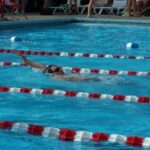Butterfly, American crawl, breast stroke , backstroke, these are the strokes Olympic swimmers practice and race with. These strokes are all engineered for speed and power. Each will likely get the swimmer where he wants to go quickly. There is nothing wrong with any of these strokes but if you want to master a stroke that will take you on a more leisurely pace to your destination, then learning the side stroke might be something to consider.
Take the position. Unlike any other stroke you may learn, the side stroke is performed neither on your stomach, nor on your back . As the name indicates to swim this stroke you need to establish a position on your side. Getting onto your side in the water and maintaining that position may be one of the more difficult parts of the stroke. Holding this position however is crucial because it allows your body to move smoothly through the water. Rolling onto your stomach or back means creating friction with the water and slowing your progress.
You can learn the side position best by trying it first on your floor at home or in the sand at the beach. Either experience will get you ready to try the side position later on in the water. You may practice on either side but it seems that right handed people like to lie on their right side, while lefties choose the left. ( eventually you will learn to do the same stroke on both sides.) Where ever you try the side position first you will want to lay down on your hip and stretch your legs out in a straight line below your hips . Place the arm that is closest to the ground out flat directly up from your shoulder so that your shoulder creates a pillow for your head.Your arm should then be fully extended along the floor . From the tip of this hand to your toes your body should be arranged in a straight line. Your upper arm for the moment should simply lie along the top of your body. It is this side position that you will need to take into the water to begin learning the side stroke.
The side glide. Once you have mastered the side position on dry land it’s time to take it into the water. Learning the side stroke in the water begins by walking into waste deep water, facing shore and then turning sideways so that you are no longer facing in towards shore or out towards deep water but are halfway in between . Now kneel down so that your shoulders are beneath the water. This will help you to move into your side glide. When your are ready extend your arm towards the shore and let your body follow taking the same position you had when practicing on land. This time however you are gliding in the water and getting the feeling for the first time of what it means to be on your side in the water.
You will not be able to maintain the side glide position for young . The side glide by itself will not take you far. You will need to learn the leg and arm stroke to use in this position that will both propel you and keep you afloat as you move through the water.
The Scissor Kick. The main propulsion for the side stroke comes from your legs, so in learning the sidestroke the scissor kick is learned first,after the side glide. You can learn and practice the scissors kick on dry land or you can attempt it in shallow water. In either case begin by taking a side position and bracing yourself with your bottom arm extended as in the side glide and your top arm braced on the bottom (or floor ) to help you maintain your side position. It is important to try to keep yourself stretched out and on your side while practicing your kick
The leg movement is similar to the split action of a scissors, thus the name. To execute the kick the swimmer first draws the two legs up by bending them at the knees. When they are fully bent the two legs part company with the leg closest to the surface reaching forward and underneath leg reaching backward. Both legs reach as far in opposite directions with legs eventually straightening out completely. The legs are now in position to use their strength to propel the body forward. This is done by squeezing the legs hard back together into their original position. To practice the scissors kick you can count to yourself. “Bend, spread, squeeze and glide. These are the four motions the legs experience. It is important not to forget the glide as that is the time during which the body shoots forward in the water while it is in a straight but relaxed position.
This kick should now be coordinated with the side glide. You should be able to do several kicks while in the side glide position . Be careful not to roll onto your stomach or you will find yourself swimming in circles. Without an accompanying stroke it is difficult to hold your position in the water .
The Arm stroke. The arms perform different but related motions at the same time. The bottom arm ( the one that is under your head as you take the side position) first pulls down straight through the water until in glide position it is directly under the shoulder with fingers pointing towards the bottom. Reaching that position the arm is then bent and the hand comes to rest directly in front of the swimmers chest. At the same time the upper hand ( the one that is lying on top of your body ) is first bent and drawn along the top side of the body and then reaches to meet the other hand in front of the swimmers chest. In a coordinated move the two hands are thrust back to their original positions creating balance and additional propulsion.
The arm stroke often requires practicing each arm separately and then practicing the two arms together. But you may also find that if you practice the arms on dry land first the stroke will seem much easier to do in the water.
Coordination. With the arm and leg stroke mastered the final step in learning the sidestroke is coordinating the two body parts, arms and legs together.
As the legs bend the arms move through the water ( bottom arm reaching down through the water and top arm passing along the body ). As the legs reach out the hands meet together in front of the body and turn to prepare to push outwards. When the legs snap together the arms push through the water,arms and legs creating propulsion at the same time. Remember the importance of gliding after each completed stroke. This will help your body to move smoothly and it also allows you to regroup for the next stroke.
The sidestroke is one of the most relaxing strokes you can attempt. It does take some coordination as well as adaptation to being on your side. But the effort will in the end give you the kind of silky smooth stroke that will carry you wherever you want to go and deposit you there without exhausting you in the process.


